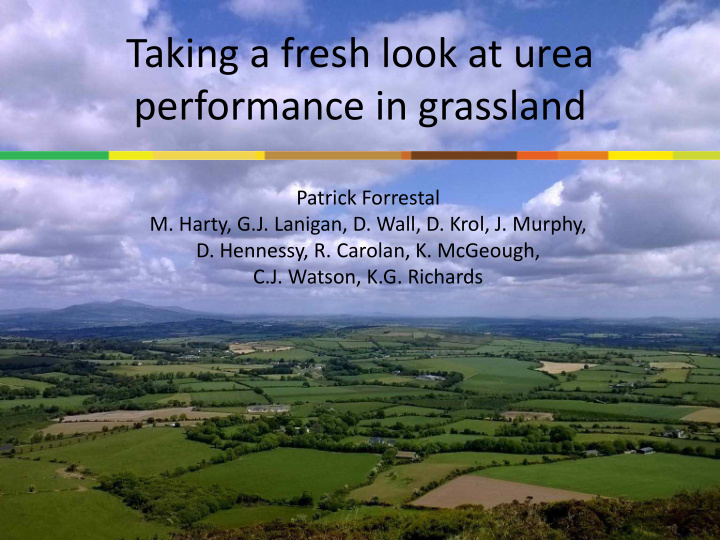



Taking a fresh look at urea performance in grassland Patrick Forrestal M. Harty, G.J. Lanigan, D. Wall, D. Krol, J. Murphy, D. Hennessy, R. Carolan, K. McGeough, C.J. Watson, K.G. Richards
First a question for you: What happens on your farm, have you used urea in the past year? • Yes • No
Urea, Why look at it now? Cost & yield GHG Ammonia (NH 3 ) • Urea-N costs less • Ag. approx. 1/3 • Urea looses NH 3 than CAN-N: 26% national emissions • Ag. accounts for c. less (CSO, 2014) 98.5% of national • committed to • Is there a yield emissions reduce by 20% by penalty? • Substantial 2020 • Internationally pressure to reduce • N addition causes urea is more these emissions N 2 O loss available than CAN on horizon • Smart solutions
Field trials to evaluate urea performance compared with CAN • Sites covering a range of conditions • Urea and stabilised urea compared with CAN • Applied throughout the year, rates 0–500 kg N/ha/yr in 5 splits • Yield response measured by cutting • Applied on a pre-selected day
NO NH 3 NO N 2 O N 2 O N 2 N 2 Urease Nitrosomonas Nitrobacter et al et al Uptake Uptake N stabiliser
Annual yield under CAN, Urea, Urea+NBPT 3 sites 2 years 16000 Grass Dry Matter Yield (kg/ha) 14000 12000 10000 CAN Urea 8000 Urea+NBPT 6000 0 100 200 300 400 500 Annual N rate (kg N/ha)
N concentration in grass 3.5 Grass N content (% N in D.M.) 3.0 2.5 CAN Urea Urea+NBPT 2.0 0 100 200 300 400 500 Annual N rate (kg N/ha)
Behind the average, individual cuts? Orange: March/April applications, black summer applications Advantage CAN Advantage Urea 1 -600 -400 -200 0 200 400 600 Yield difference between CAN and urea (kg/ha)
Applying urea for early growth
Spring 2013 Johnstown Castle 4500 4000 Late May Grass Dry Matter Yield (kg/ha) mean air temp (14 o C) 3500 3000 2500 2000 April 29 app mean air temp (10 o C) 1500 1000 500 March 19 app mean air temp (6 o C) 0 0 20 40 60 80 100 N rate (kg N/ha)
Urea compared with CAN for early growth vs summer Combined data from current Teagasc trials and extensive work in late 1970’s early 80’s 102 Yield from urea as a % of CAN yield 100 98 R² = 0.52 96 94 R² = 0.70 Spring applications 92 Summer applications 90 0 30 60 90 120 150 N rate (kg/ha)
Greenhouse gas mitigation? 2.0 Source: M. Harty et al. in prep Urea and stabilised urea: mean reduction in total N 2 O loss = circa 70% 1.5 N 2 O emission factor (%) 1.0 CAN Urea Urea+NBPT 0.5 0.0 1
Ammonia loss can be highly variable between applications • Variable loss of NH 3 can be an issue at all times of the year • Peak loss rates reached < 3 days but often within 24 hrs • As urea N rate increases the percentage N loss tends to increase • Urea stabilised with NBPT reduced NH 3 loss by 78.5% Source: Forrestal, P.J., Harty, M., Carolan, R., Lanigan, G.J., Watson, C.J., Laughlin, R.J., NcNeill, G., Chambers, B., Richards, K.G. Ammonia emissions from urea, stabilised urea and calcium ammonium nitrate: insights into loss abatement in temperate grassland Soil Use and Management. In press.
Conclusions Cost & yield • Urea costs less, gives comparable yield performance to CAN but total N recovery is lower. GHG • Urea based N offers potential to sustain or increase national N usage with reduced N 2 O Ammonia • Urea stabilised with NBPT reduced ammonia loss by 78.5% on average • Further understanding of ammonia loss and development of management solutions is needed
Acknowledgements DAFM funding through Research Stimulus Fund SUDEN & AGRI-I projects Field & lab staff, Ph.D, M.Sc, summer students, interns Partners at Agri-Food & Biosciences Institute Questions/comments welcome
Recommend
More recommend